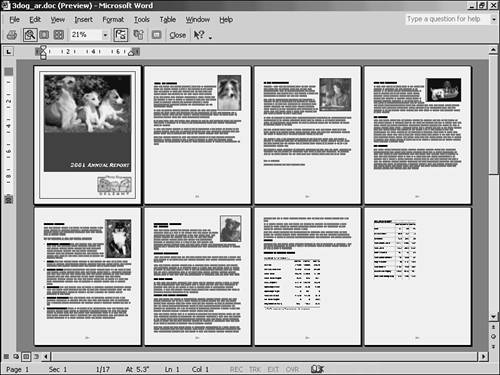Printing Word Documents
When you get right down to it, most Word documents are destined for the printer. Word offers many features to give you extensive control over how pages print.
Previewing Printed Pages
If you're looking at one page, Word's Print Preview mode offers no advantage over the standard Print Layout view. But there are two situations in which Print Preview is extremely useful. Click the Multiple Pages button and drag to show as few as two or (depending on hardware) as many as 60 pages at one time (Print Layout view's Zoom setting goes up to only 6 pages). This view is especially helpful when you want to see at a glance where headlines, graphics, tables, and other nontext elements fall in your document. Although it's possible to edit text and move objects on the Print Preview screen, this screen is most appropriate for getting a bird's-eye view of your entire document.
To enter Word's Print Preview mode (see Figure 14.14), click the Print Preview button on the Standard toolbar, or choose File, Print Preview.
Figure 14.14. Word's Print Preview mode shows you precisely how the printed page will appear—but Print Layout view does almost as well, with none of the limitations.

Tip from 
In Print Preview mode, the default mouse pointer lets you toggle between a 100% view of the page you click or back to a view of the number of pages you selected. Click the Magnifier button to toggle between this pointer and an I-beam insertion point you can use for editing.
In Print Preview mode, you also have access to the Shrink to Fit button. Use this feature when the last page of your document includes two or three lines, and you want to force those leftovers to fit on the previous page.
Click the Shrink to Fit button and Word alters font sizes to reduce the number of pages in the document by one. Note that changing the font size sometimes doesn't affect the spacing between paragraphs, so the resulting document might have an inordinate amount of whitespace. Also, the Shrink operation makes no changes to margins. Word won't reduce font sizes below the range of 6 or 7 points.
Caution
While in Print Preview mode, you can click the Undo button or press Ctrl+Z to reverse the Shrink to Fit operation, but after you've closed and saved the document, it's impossible to return the document to its original state.
Choosing What to Print
If you want to print one copy of the current document using the defaults established on the Print tab of the Options dialog box (see the Print What Choices table later in this chapter), click the Print icon on the Standard toolbar.
Word also allows you to print the currently selected page(s), or to specify the pages you want to print by page number. To invoke either of those options, choose File, Print, and select Current Page or type in the page numbers in the Pages box (see Figure 14.15).
Figure 14.15. Word 2002's Print allows you to print "thumbnail" images, two or four (or more) to a page, using the Pages per sheet box.

The Print box lets you print all pages, or odd or even pages only. If you know how your printer feeds sheets, you can use this setting to print "duplex"—where pages alternate on the front and back of each sheet.
Tip from 
If you check the Print to File box in the Print dialog box, Word prompts you for a filename. If your printer is currently unavailable, but you want to produce a hard copy of a document you're working with now, it can be a good option. Later, when the printer is available, you don't need to reopen Word; just copy the file you created directly to your printer by, for example, dragging it onto the printer icon in Windows Explorer.
Ever wonder what AutoText entries you have set up in a particular document or template? How about the styles, or many other hidden parts of your document, for that matter. Choices in the Print What drop-down list let you find out (see Table 14.3).
| Option | What Prints |
|---|---|
| Document Properties | Some of the information found in the dialog box that appears when you choose File, Properties: all the Summary information, and some of the General and Statistics |
| Document Showing Markup | Prints the document with track changes items, including comments, in the margin; it does not print the style area |
| Styles | All the styles that you can see if you choose Format, Styles, and select Styles in Use |
| AutoText entries | All AutoText entries available in the document, whether they originate in the document's template or the Normal global document template, Normal.dot |
| Key Assignments | Only custom keyboard assignments for the current document, template, and global |
Printing Thumbnails
The Pages Per Sheet list in the Print dialog box (refer to Figure 14.15) offers you the opportunity to print thumbnails of your documents—2, 4, 6, 8, or 16 pages—on a single sheet of paper.
Tip from 
If your primary reason for printing is to file away a hardcopy record of your documents, consider printing 2-up or 4-up, duplex if possible. Although you might need a magnifying glass to read the resulting printout, the storage space savings are enormous.
Collating
If you choose to print more than one copy of a document, Word's default settings collate the copies for you—printing one copy from start to finish, and then printing the next copy from start to finish, and so on. That's convenient if you want to pull the pages right out of the printer and pass them around without any additional work.
